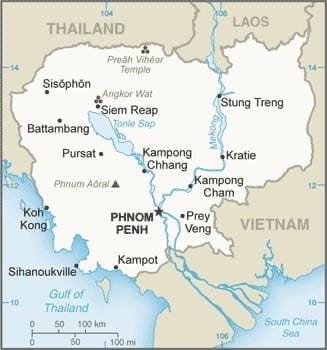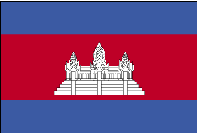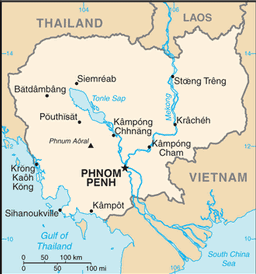Official Name: Kingdom of Cambodia
Internet Domain: .kh
International Dialing Code: +855
| Location and Size | Credit and Collections |
| Government | Risk Assessment |
| Legal System | Business Climate |
| Interesting Facts | Business Protocol |
| Economy | |
| Comparative Economic Indicators |
Location and Size
Cambodia is located in Southeast Asia on the Gulf of Thailand. Neighboring countries include Laos, Thailand and Vietnam. Cambodia’s total land area is 176,515 sq. kms.
Government
Cambodia is a multiparty democracy under a constitutional monarchy. The country consists of 23 provinces and 1 municipality. The capital is Phnom Penh.
Branches of Government
- Executive: Chief of State: King Norodom Sihamoni; Head of Government: Prime Minister HUN SEN; Cabinet: Council of Ministers named by the prime minister and appointed by the monarch
- Legislative: Bicameral consisting of National Assembly (123 seats elected by popular vote); Senate (61 seats, 2 appointed by the monarch; 2 elected by the National Assembly; 57 elected by parliamentarians and commune councils)
- Judicial: Supreme Council of the Magistracy; Supreme Court
Legal System
Cambodia has a civil law system (influenced by the UN Transitional Authority in Cambodia), customary law, Communist legal theory, and common law.
Cambodia accepts compulsory International Court of Justice (ICJ) jurisdiction with reservations. The country also accepts International Criminal Court (ICCt) jurisdiction.
Interesting Facts About Cambodia
- Most Cambodian young men are Buddhist monks for a short time.
- After the civil war in Cambodia (1970-1975), 4 million existing landmines continue to cause casualties. It will be another ten years before all the landmines are removed or destroyed.
- 300-700 amputations per month are caused by the nearly 4 million landmines still in existence after the civil war.
- The Cambodian flag is the only flag in the world that features a building.
- 1 in 236 Cambodians is disabled, making Cambodia the most disabled country on earth.
- Cambodia has one of the world’s largest religious monuments: the Angkor Wat, which is dedicated to the Hindu god Vishnu.
- Cambodia has one of the highest deforestation rates in the world. Since 1970, forest coverage has decreased from 70% of its land area to just 3%.
- Tarantula kebabs are a popular food item in Cambodia.
- The largest river in Southeast Asia, the MeKong, flows across Cambodia.
- The official currency in Cambodia is the Riel; however the most common currency found in Cambodia is the U.S. dollar.
Economy
Cambodia has experienced strong economic growth over the last decade. The tourism, garment, construction and real estate, and agriculture sectors accounted for the bulk of growth. Around 700,000 people, the majority of whom are women, are employed in the garment and footwear sector. An additional 500,000 Cambodians are employed in the tourism sector, and a further 200,000 people in construction. Tourism has continued to grow rapidly with foreign arrivals exceeding 5.6 million visitors in 2017. Mining also is attracting some investor interest and the government has touted opportunities for mining bauxite, gold, iron and gems.
Leading Markets (2018): US 47.3%, Canada 7.5%, UK 6.8%, Germany 6.4%, Thailand 4.3%, Japan 4.1%
Leading Exports – Commodities: Clothing, timber, rubber, rice, fish, tobacco, footwear
Leading Suppliers (2018): Thailand 26.5%, Singapore 25.1%, China 15.3%, Hong Kong 6.6%, Vietnam 6.5%
Leading Imports – Commodities: petroleum products, cigarettes, gold, construction materials, machinery, motor vehicles, pharmaceutical products
Top Industries: Tourism, garments, construction, rice milling, fishing, wood and wood products, rubber, cement, gem mining, textiles
Top Agricultural Products: Rice, rubber, corn, vegetables, cashews, tapioca, silk
Comparative Economic Indicators
| Cambodia | China | Japan | Laos | Thailand | Vietnam | |
| Population* (millions) | 14.7 | 1,336.8 | 126.5 | 6.5 | 66.7 | 90.5 |
| Population growth rate* (%) | 1.7 | 0.5 | -0.3 | 1.7 | 0.6 | 1.1 |
| Age Structure (%) (15 to 64 years old) |
64.1 | 73.6 | 64.0 | 59.6 | 70.9 | 69.3 |
| Age Structure (%) (65+ years old) |
3.8 | 8.9 | 22.9 | 3.7 | 9.2 | 5.5 |
| Literacy (%) | 73.6 | 92.2 | 99.0 | 73.0 | 92.6 | 94.0 |
| Unemployment rate (%) | 3.5 | 6.1 | 5.0 | 2.5 | 1.0 | 4.4 |
| Inflation (%) | 4.0 | 3.2 | -0.7 | 5.7 | 3.3 | 9.0 |
| Population below proverty line (%) | 31.0 | 2.8 | 15.7 | 26.0 | 9.6 | 10.6 |
| GDP** (USD billions) | 30.2 | 10,090.0 | 4,310.0 | 15.7 | 586.9 | 276.6 |
| GDP real growth rate (%) | 6.0 | 10.3 | 3.9 | 7.7 | 7.8 | 6.8 |
| GDP per capita** (USD) | 2,100.0 | 7,600.0 | 34,000.0 | 2,500.0 | 8,700.0 | 3,100.0 |
| Public debt (% of GDP) | unknown | 16.3 | 199.7 | unknown | 43.1 | 57.1 |
| Exports (USD billions) | 5.5 | 1,581.0 | 730.1 | 1.5 | 193.5 | 72.3 |
| Imports (USD billions) | 7.4 | 1,327.0 | 639.1 | 2.1 | 161.3 | 80.0 |
| Reserves of foreign exchange and gold (USD billions) | 3.8 | 2,876.0 | 1,063.0 | 0.7 | 172.1 | 12.9 |
| Currency | Reil KHR |
Yuan Renminbi CNY |
Yen JPY |
Kip LAK |
Baht THB |
Dong VND |
| Exchange rates (per USD) 1/30/2019 | 3,961.4 | 6.4 | 77.9 | 7,863.0 | 31.2 | 20,823.7 |
| Exchange rates (per EUR) 1/30/2019 | 5,284.1 | 8.5 | 103.9 | 10,485.8 | 41.7 | 27,769.9 |
** PPP ” Purchasing Power Parity
Economic Data from CIA World Factbook
Credit and Collections
Dispute Resolution
The local and foreign business community reports frequent problems with inconsistent judicial rulings, corruption, and difficulty enforcing judgments. For these reasons, most commercial disputes are currently resolved by negotiations facilitated by the Ministry of Commerce, the Cambodian Chamber of Commerce, and other concerned institutions.
Risk Assessment
Business Climate
Cambodia, which has been politically stable since the late 1990’s, continues to integrate into the global trading framework. There has been notable reform in the management of public finances and the trade regime is more open and transparent.
Cambodia has removed most of its non-tariff trade barriers, but import bans and restrictions, discretionary tax levies, non-automatic import licensing, non-transparent government procurement, weak enforcement of intellectual property rights, and inconsistent and cumbersome customs administration add to the cost of trade.
Economic Freedom: Cambodia’s score in the 2019 Index of Economic Freedom is 57.8, ranking it as the 105th freest (out of 179) in the Index. It is ranked 22 out of 41 countries in the Asia-Pacific region and its overall score is slightly higher than the regional average.
Market Access: All sectors of the economy are open to foreign investment and 100 percent foreign ownership is permitted in most sectors. In a few sectors, foreign investment is subject to conditions, local equity participation, or prior authorization from authorities. There are no limits on the rights of foreign and domestic entities to establish and own business enterprises or to compete with public enterprises. However, only Cambodian citizens or legal entities have the right to own land.
Regulatory System: There is no pattern of discrimination against foreign investors in Cambodia through a regulatory regime. Numerous issues of transparency in the regulatory system do arise, however, from the lack of legislation and the weakness of key institutions. Investors often complain that the decisions of Cambodian regulatory agencies are inconsistent, irrational, or corrupt.
Intellectual Property Rights: Cambodia is a member of the World Intellectual Property Organization (WIPO) and the Paris Convention for the Protection of Industrial Property. Cambodia’s IPR legal regime is in compliance with its WTO member commitments. However, infringement of IPR is pervasive and local businesses report that Cambodia is becoming an increasingly popular source of pirated material due to weak enforcement.
Exchange Control: There are no restrictions on the conversion of capital for investors.
Corruption: Corruption tops the list of obstacles for doing business in Cambodia. According to estimates, 10% of Cambodia’s annual GDP is lost to corruption. The government passed a controversial anti-graft law. Several observers have expressed concern about the new law as it contains loopholes for corruption, such as no provision of protection for whistle blowers.
Political Violence: The risk of political violence directed at foreign companies operating in Cambodia is relatively small. Some violent protests have occurred in the past, such as anti-Thai riots in 2003 against the Embassy of Thailand and Thai-owned commercial establishments. However, the Department of State is unaware of any recent incidents directed at American or other Western interests.
Business Protocol in Cambodia
- The traditional greeting in Cambodia is a bow combined with a bringing of the hands together at chest level (similar to bringing hands together for prayer). With foreigners, Cambodians have adopted the western practice of shaking hands. Women may still use the traditional Cambodian greeting.
- In Cambodia people are addressed with the honorific title “Lok” for a man and “Lok Srey” for a woman followed with the first name or both the first and surname.
- Cambodia has a hierarchical culture and the business community follows suit in terms of protocol and behavior. Respect and deference must always be shown to the most senior person. When meeting you should have the most senior member of your group greet the highest ranking Cambodian person.
**********
Subscribe to the Credit-to-Cash Advisor
This information is provided by ABC-Amega Inc. Providing international receivable management and debt collection services for exporters to more than 200 countries including Cambodia. For further information, contact [email protected].


